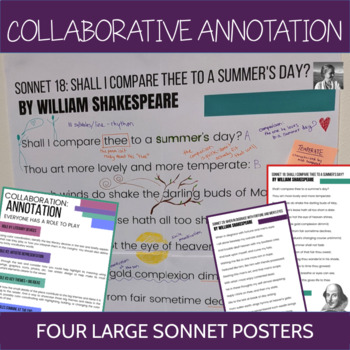Annotating Text: Collaborative Roles
- Zip
- Google Apps™

What educators are saying
Description
Want to coach your students on improving their annotation of text? Try this fun collaborative activity with giant Shakespeare sonnet posters on your wall, then use the model you've introduced students to over and over with any text.
This activity helps students hone their annotation style and practice effective annotation, plus it gives you visual models for your walls to help continue reinforcing the principles of good annotation as long as you keep your posters up.
Here's how it works:
Divide your class into groups. Give them each a copy of the annotation roles and let them choose what to focus on.
Then give each group the puzzle pieces for one giant sonnet poster (there are four sonnets included here), some scissors, tape, markers, and sticky notes if you have them.
Each group will assemble their poster on the wall, then annotate it using their roles. The last step on the instructions is for each group member to share what they added according to their roles, and then talk together about what questions they can add in the margins based on what they've learned.
Finally, let groups present to a partner group and do a gallery walk. By the end of the day, students will have seen many models for annotation style to help them further develop what works best for them.
Once you introduce this activity with these Shakespearean sonnet posters, you can use the collaborative annotation roles to guide students in close readings of any text throughout the year.
What's included:
- Collaborative Roles Guiding Handout
- Example
- 4 Large Sonnet Posters (each poster is divided onto six slides for printing)
Looking for more annotation resources? Check these out:
Annotation Guided Practice: Use these five guided annotation practices with any text. Students focus on one skill, developing their repertoire of options for when they are annotating independently.
Annotation Illumination: Show students the power of annotation when they showcase their annotation of one text with color, imagery, and depth. This memorable project will make a great addition to your walls, and help students develop their personal annotation style.
Annotation Posters: Reinforce the creative foundations of effective annotation with these colorful posters.





